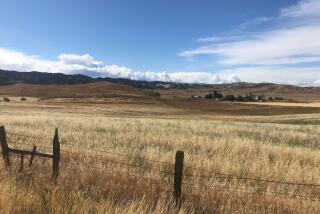California Retrospective: How a 1930s water war between California and Arizona delayed Parker Dam
- Share via
“Water war” has for decades been a term used to describe the political battles over water in the West.
But back in the 1930s, a fight between California and Arizona over water actually veered from cold war to hot war — almost.
In 1934, the Metropolitan Water District began construction on Parker Dam, which was opposed by Arizona. The resulting Lake Havasu would feed the new Colorado Aqueduct.
Before, in 1922, six of seven states signed the Colorado River Compact. Upset with its allotment, Arizona refused to sign.
So when Parker Dam construction began, Arizona sought to block the project.
In March 1934, Arizona Gov. Benjamin Moeur called up the Arizona National Guard. Six soldiers arrived in Parker, Ariz., to observe the construction.
National media, including the Los Angeles Times, ridiculed the deployment.
When an Associated Press photo appeared in the March 10, 1934, edition of The Times, the accompanying caption reported:
“Arizona Troops Leave For (Water) Front.
“Without any flare of trumpets or a band playing martial airs, this squad of Arizona National Guardsmen left Phoenix and arrived at Parker yesterday preparatory to patrolling the dam site to prevent ‘encroachment’ on Arizona’s rights by the Metropolitan Water District. Maj. Pomeroy, commanding the detail, is shown on the extreme right.”
For the next several months, the troops patrolled the Arizona side of the dam site.
In November, the construction of a trestle bridge from the California side prompted action. On Nov. 10, Moeur declared martial law. He dispatched more than 100 National Guard troops to block construction on Arizona’s shore.
U.S. Secretary of the Interior Harold L. Ickes intervened and halted construction. The troops were recalled.
The resulting legal action led to an April 29, 1935, Supreme Court decision. The April 30, 1935, Los Angeles Times reported:
“Without a dissenting voice, the United States Supreme Court yesterday forced an indefinite suspension of work on Parker Dam by upholding Arizona’s right to object and interfere with construction....
“Arizona officials, a dispatch from Phoenix said, hailed the decision as a victory in their battle over the Colorado River, which has been waged for twelve years.
“Gov. Moeur, who last November ordered out the Militia to stop construction, was quoted as saying he was pleased; and he and other State authorities indicated they now intend to let other sides in the controversy make the first move.
“By its far-reaching decision, the Supreme Court virtually justified Gov. Moeur’s action in ordering out the troops.
“The decision, written by Justice (Pierce) Butler, assert the dam project never has been authorized by law.”
Political compromises were made. Congress passed legislation allowing construction to proceed. Parker Dam was finished in 1938.
ALSO
Appeals panel set to hear arguments on constitutionality of state’s death penalty system
If L.A. bids for 2024 Olympics, will taxpayers be on the hook?
Compton mayor’s charity tie-in to State of the City talk raises eyebrows
More to Read
Sign up for Essential California
The most important California stories and recommendations in your inbox every morning.
You may occasionally receive promotional content from the Los Angeles Times.










